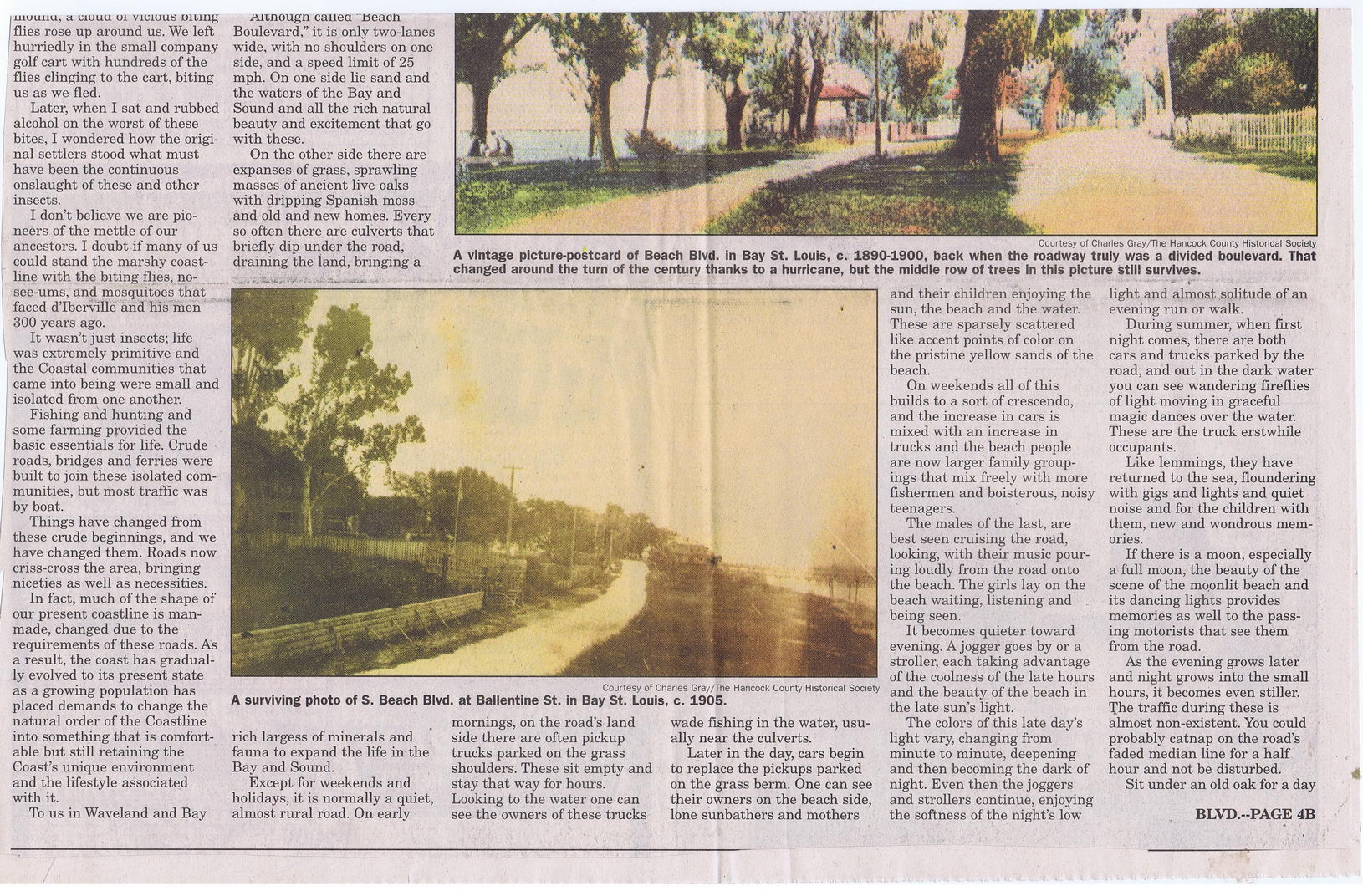This text was obtained via automated optical character recognition.
It has not been edited and may therefore contain several errors.
jiiiuLuiu, a. uiouu ui vicious Dlling | flies rose up around us. We left hurriedly in the small company golf cart with hundreds of the flies clinging to the cart, biting us as we fled. Later, when I sat and rubbed alcohol on the worst of these bites, I wondered how the original settlers stood what must have been the continuous onslaught of these and other insects. I don’t believe we are pioneers of the mettle of our ancestors. I doubt if many of us could stand the marshy coastline with the biting flies, no-see-ums, and mosquitoes that faced d’Iberville and his men 300 years ago. It wasn’t just insects; life was extremely primitive and the Coastal communities that came into being were small and isolated from one another. Fishing and hunting and some farming provided the basic essentials for life. Crude roads, bridges and ferries were built to join these isolated communities, but most traffic was by boat. Things have changed from these crude beginnings, and we have changed them. Roads now criss-cross the area, bringing niceties as well as necessities. In fact, much of the shape of our present coastline is man-made, changed due to the requirements of these roads. As a result, the coast has gradually evolved to its present state as a growing population has placed demands to change the natural order of the Coastline into something that is comfortable but still retaining the Coast’s unique environment and the lifestyle associated with it. To us in Waveland and Bay Aimougn cauea \eeacn Boulevard,” it is only two-lanes wide, with no shoulders on one side, and a speed limit of 25 mph. On one side lie sand and the waters of the Bay and Sound and all the rich natural beauty and excitement that go with these. On the other side there are expanses of grass, sprawling masses of ancient live oaks with dripping Spanish moss and old and new homes. Every so often there are culverts that briefly dip under the road, draining the land, bringing a Courtesy of Charles Gray/The Hancock County Historical Society A vintage picture-postcard of Beach Blvd. in Bay St. Louis, c. 1890-1900, back when the roadway truly was a divided boulevard. That changed around the turn of the century thanks to a hurricane, but the middle row of trees in this picture still survives. Courtesy of Charles Gray /The Hancock County Historical Society A surviving photo of S. Beach Blvd. at Ballentine St. in Bay St. Louis, c. 1905. rich largess of minerals and fauna to expand the life in the Bay and Sound. Except for weekends and holidays, it is normally a quiet, almost rural road. On early mornings, on the road’s land side there are often pickup trucks parked on the grass shoulders. These sit empty and stay that way for hours. Looking to the water one can see the owners of these trucks wade fishing in the water, usually near the culverts. Later in the day, cars begin to replace the pickups parked on the grass berm. One can see their owners on the beach side, lone sunbathers and mothers and their children enjoying the sun, the beach and the water. These are sparsely scattered like accent points of color on the pristine yellow sands of the beach. On weekends all of this builds to a sort of crescendo, and the increase in cars is mixed with an increase in trucks and the beach people are now larger family groupings that mix freely with more fishermen and boisterous, noisy teenagers. The males of the last, are best seen cruising the road, looking, with their music pouring loudly from the road onto the beach. The girls lay on the beach waiting, listening and being seen. It becomes quieter toward evening. A jogger goes by or a stroller, each taking advantage of the coolness of the late hours and the beauty of the beach in the late sun’s light. The colors of this late day’s light vary, changing from minute to minute, deepening and then becoming the dark of night. Even then the joggers and strollers continue, enjoying the softness of the night’s low light and almost solitude of an evening run or walk. During summer, when first night comes, there are both cars and trucks parked by the road, and out in the dark water you can see wandering fireflies of light moving in graceful magic dances over the water. These are the truck erstwhile occupants. Like lemmings, they have returned to the sea, floundering with gigs and lights and quiet noise and for the children with them, new and wondrous memories. If there is a moon, especially a full moon, the beauty of the scene of the mo.onlit beach and its dancing lights provides memories as well to the passing motorists that see them from the road. As the evening grows later and night grows into the small hours, it becomes even stiller. The traffic during these is almost non-existent. You could probably catnap on the road’s faded median line for a half hour and not be disturbed. Sit under an old oak for a day BLVD.-PAGE 4B

BSL 2001 To 2004 BSL 2001 To 2004 (024)